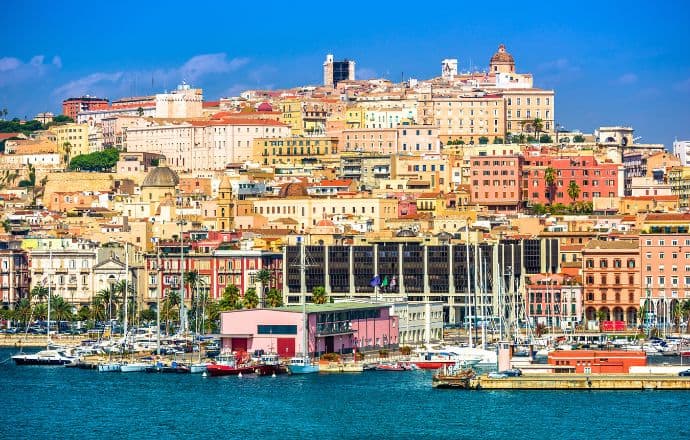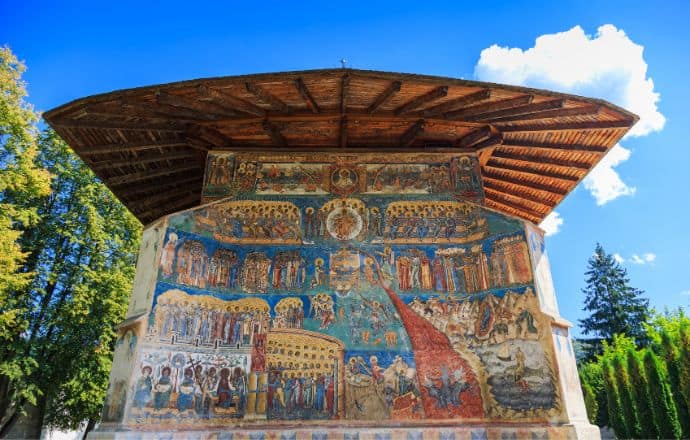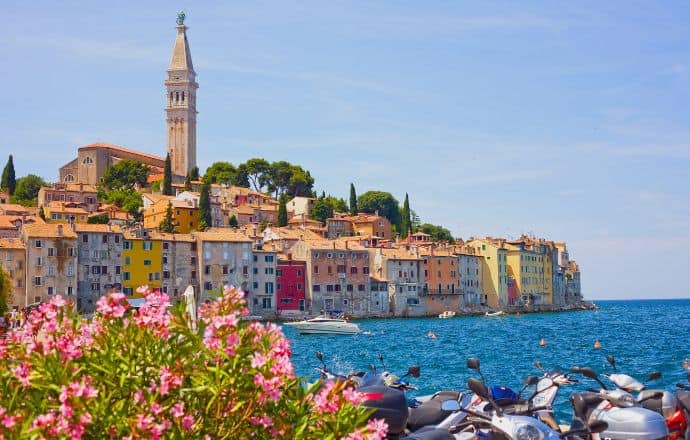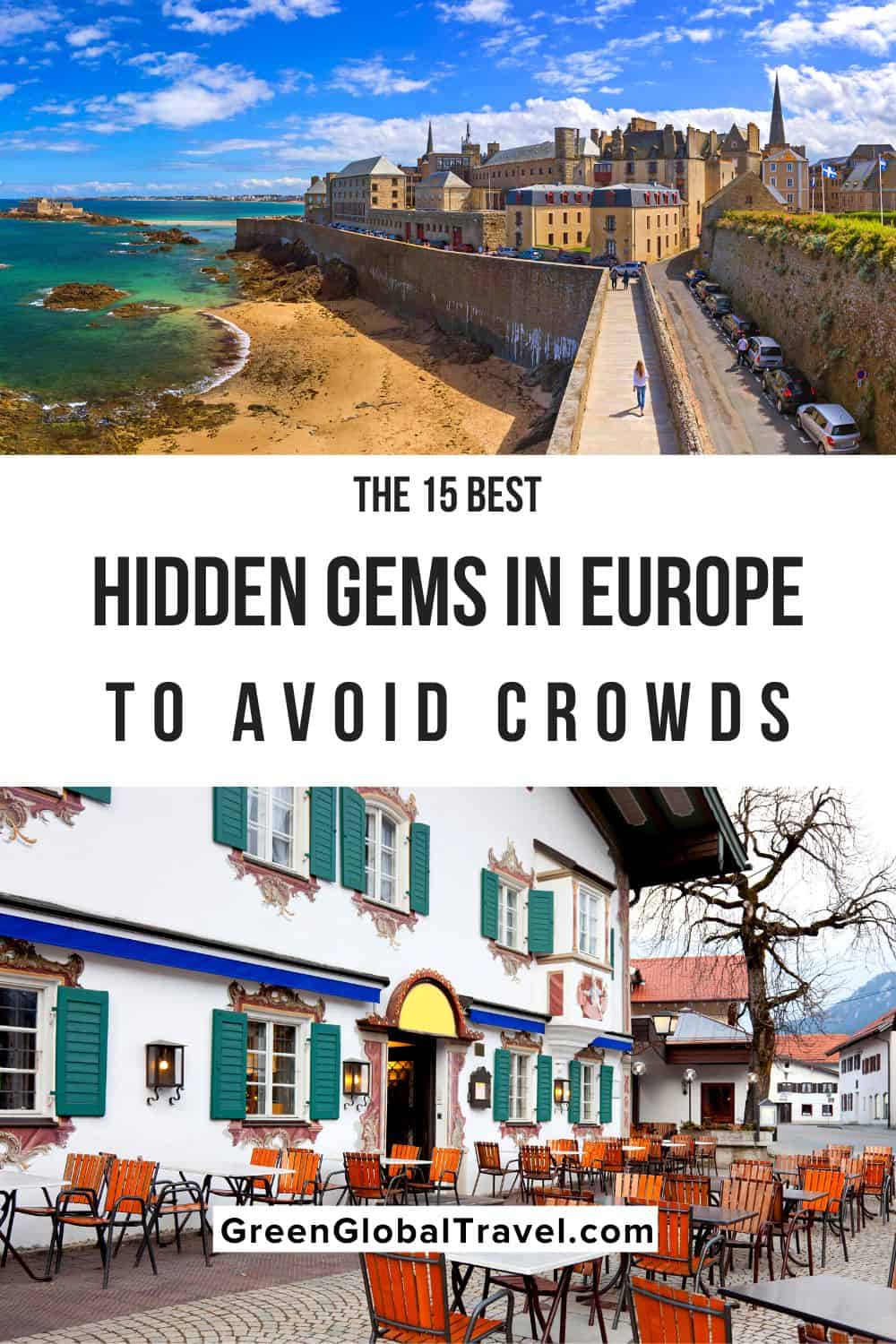The 15 Best Hidden Gems in Europe to Avoid Crowds
12 min read
Table of Contents
In recent years, summer in Europe has brought the increasingly negative impacts of mass tourism, but there are still hidden gems in Europe. Off the beaten path Europe cities, islands, and regions do exist without crowds.
Every peak European travel season seems to bring more unfortunate issues, increasing the rift between locals and visitors and prompting calls to curb tourist numbers.
Overtourism has long-lasting consequences, increasing the property and rental prices, driving locals away from their hometowns, and turning historic centers into living museums.
In the process, the cultural heart of these destinations all too often seems to get lost.
If your dream European vacation includes sailing the canals of Venice or wandering the streets of Florence in solitude, you’ll likely find the reality pales in comparison to the fantasy.
Unless you visit during the off season, you may find yourself among hordes of tourists attracted by cheap European travel packages.
But while visitor numbers to these crowded hotspots seem to increase every year, there are still many hidden gems in Europe that remain off the beaten path.
There are countless beautiful underrated European cities where few travelers know to venture, with ample natural, cultural, and historical attractions and a fraction of the crowds you’ll find in European cities like Barcelona, Rome, and Paris.
From the Arctic to the Mediterranean, we’ve pored over the map and come up with our 15 of the best hidden gems in Europe.
READ MORE: The 30 Best Places to Spend Christmas in Europe
;
Best Hidden Gems in Europe Guide
(Arranged geographically)
- Greenland
- Iceland’s Westfjords
- Svalbard (Norway)
- Gotland (Sweden)
- Shetland Islands (Scotland)
- Jersey (Channel Islands)
- Brittany (France)
- Oberammergau (Germany)
- Galicia (Spain)
- Sardinia (Italy)
- Sicily (Italy)
- Azores (Portugal)
- The Black Sea
- Transylvania (Romania)
- Istria (Croatia)
READ MORE: 15 Reasons Responsible Tourism Is Better for Everyone
NORDIC EUROPE HIDDEN GEMS

1. Greenland
There are approximately 90,000 annual visitors to Greenland– a far cry from the 20 million tourists who travel to Venice every year.
Considering the fact that Greenland is Europe’s largest island, your chances of being stuck in selfie-stick-brandishing crowds there are slim to none. Yet Greenland is a must-visit for lovers of nature and of the Arctic.
It’s worth a visit in winter to experience the Polar darkness, and for the high likelihood to see Northern Lights in Kangerlussaq (where they appear approximately 300 nights each year).
In summer you can have fun round-the-clock under the midnight sun, enjoying adventure activities including kayaking in iceberg-filled lagoons and exploring the Ilulissat Icefjord, a UNESCO World Heritage Site (and one of the world’s few growing glaciers).
Greenland is also unique in Europe because it’s the only place where you can learn about Inuit culture.
Qaanaaq, formerly known as Thule, is an Inuit town located at 77.4° north, making it one of the northernmost inhabited places in the world. It’s home to around 700 people, and tourists can learn about their culture and traditions.
READ MORE: Arctic Animals: 30 Species of Arctic Birds, Mammals & Whales

2. Iceland’s Westfjords
Iceland is another place that’s often mentioned when talking about overtourism.
Its problems range from visitors flocking to a canyon once featured in a Justin Bieber video to locals enraged after seeing tourists using their gardens and fields as toilets.
Bot most Iceland tourism is concentrated in the southern part of the country, in the vicinity of Reykjavik and the famous “Golden Circle.”
If you want to avoid throngs of tourists, head to the northwestern peninsula known as the Westfjords, which you can visit on small ship cruises.
Reaching the region from the capital can take close to half a day, and the roads to get there aren’t great.
But you’ll be rewarded with roaring Iceland waterfalls like Dynjandi, thousands of Iceland birds such as puffins in Latrabjarg, and free-range Icelandic Horses as well as many incredible natural pools and hot springs.
READ MORE: Experiencing Authentic Icelandic Culture

3. Svalbard (Norway)
Do you have a knack for remote places? No other European hidden gem will make you feel on the edge of the map quite as much as Svalbard, the Norwegian archipelago that lies halfway between the North Pole and continental Norway.
In summer, Svalbard is full of wildlife. Polar bears outnumber residents two to one, and you may also come across seals, walruses, whales, arctic foxes, and more.
Nature is Svalbard’s main draw: There are endless glaciers, mountains, large expanses of tundra and sea cliffs, which are inhabited by a number of migratory birds.
Yet it’s also a place for history lovers, where it’s possible to visit a 17th century whaling station and recently abandoned coal mines, like the Soviet settlement of Pyramiden.
Touring Svalbard on your own can be very dangerous. At these latitudes, nature is very wild and the danger of a polar bear attack is very real.
But there are expedition cruises to Svalbard every summer, with a focus on wildlife and finding polar bears.
READ MORE: The Norse Gods: An Intro to Viking Mythology & Key Sites in Norway

4. Gotland (Sweden)
Located in the Swedish part of the Baltic Sea, Gotland was beloved by famous film director Ingmar Bergman. He spent the last 40 years of his life in Fårö, a tiny island located just north of Gotland.
It’s a popular destination for vacationing Swedes, but it’s all but unknown among other nationalities.
Gotland is a great place for people who wish to unplug completely, spending days in a secluded cabin in the forest and occasionally walking to the beach for a refreshing dip in the sea.
Those who want to go sightseeing will also find plenty to do in Gotland. Visby, the largest town, is UNESCO-protected because it’s the best-preserved medieval town in Nordic Europe.
You can also visit the unique raukar (limestone sea stacks found on beaches all over the island), see wooden churches and medieval windmills, or even try to spot the endemic Gotland Pony.
READ MORE: 10 Things We Love About West Sweden
WESTERN EUROPE HIDDEN GEMS

5. Shetland Islands (Scotland)
You’ll find the enchanting Shetland Archipelago on the remote edge of the United Kingdom’s map, 12 hours by ferry from the northern tip of Scotland.
Not many people brave the stormy seas to reach this archipelago made up of 100 islands, only 16 of which are inhabited.
Popular sights include St. Ninian’s Isle, where you can visit the largest tombolo (two-sided beach) in the UK; the Sumburgh Lighthouse, with its colonies of migrating birds (including puffins!); and the sea cliffs of Eshaness.
We also recommend visiting the ruins of croft houses, where local Shetlanders used to live before famine caused massive migrations in the 19th century.
The remote feeling of being “in the middle of nowhere” is one of the main draws that leads intrepid travelers to the Shetland Islands, and you’ll have few others to share this fascinating place with.
READ MORE: The 10 Best Places to Visit in Scotland

6. Jersey (Channel Islands)
The island of Jersey may be diminutive in size (just 5 by 9 miles), but it includes a large variety of sights, both natural and historic.
If you’ve planned a short stay in the Channel Islands, you may quickly find yourself planning a return visit.
Its northern coast is famous for dramatic sea cliffs, which are surrounded by fields of fern and heather.
The southern part feels more genteel, with long sandy beaches and sheltered bays where you can appreciate the area’s extreme tides. For a unique experience, walk on the seabed at low tide, when the island doubles in size!
Jersey offers several castles to visit, as well as La Hougue Bie, a passage grave dating back to Neolithic times.
It’s also possible to visit bunkers and museums dating back to the time of German Occupation during World War II, including the Jersey War Tunnels, a museum located in a partially built underground hospital.
READ MORE: Beautiful European Birds: A Guide to 10 Endemic Species

7. Brittany (France)
Far away from the chaos and crowds of Southern France in summer, Brittany is another one of the great places in Europe to explore.
Located in northwest France, this region still retains a strong Celtic culture and way of life. It’s home to delicious seafood and around 1,740 miles of coastline, so you won’t ever have to worry about overcrowding.
The town of Saint Malo is one of Europe’s best-preserved fortified cities, or you can visit quaint villages like Dinan and Rochefort.
This area’s windswept beaches are perfect for taking long coastal walks or bike rides, or you can head inland to visit castles or megalithic sites.
Another fun reason to visit Brittany is to go island-hopping in the Gulf of Morbihan, where you can find 40 islands, many of which are excellent birdwatching destinations.
READ MORE: 5 Weird Foods the French Consider Delicacies

8. Oberammergau (Germany)
Oberammergau is a sleepy town in Germany’s Bavarian Alps that really springs to life once every decade.
In 1633, the inhabitants made a vow: If they were spared from the plague that was ravaging Europe at the time, they would write and produce a play about the life and death of Jesus Christ, and repeat it once every 10 years.
After 300+ years, the once-a-decade tradition of the Oberammergau Passion Play still continues today.
It typically takes place from May to October, with more than 100 performances of the 5-hour Passion Play taking place in an outdoor theatre.
Some tour operators organize a tour of Switzerland, Austria, and Germany that includes the Passion Play in Oberammergau, plus unmissable European hidden gems such as Zermatt, a pedestrian-only town with views over the mighty Matterhorn Mountain.
READ MORE: German Christmas Cookies- Lebkuchen Recipe (aka German Gingerbread)
SOUTHERN EUROPE HIDDEN GEMS

9. Galicia (Spain)
Imagine green, rolling hills, mist and low clouds, fluffy sheep grazing in the fields, wild sea cliffs, and the sound of bagpipes in the air. Now guess, what place I’m talking about?
You might be thinking of Ireland or Scotland, but the place I’m referring to is Galicia, a region in northwestern Spain overlooking the Atlantic Sea.
The best-known place in Galicia is undoubtedly Santiago de Compostela, the end point of the famous Camino de Santiago hiking trail.
You can take a day trip from Santiago to Fisterra, where pilgrims of yesteryear finally saw the ocean after their endless pilgrimage across Europe.
Or head further off the beaten track to charming Muxia to visit its stunning cliffside chapel.
Galicia is also known for its scenic wild beaches. One of the best-known beaches is As Catedrais, or The Cathedrals. When you visit, you’ll immediately see why!
READ MORE: 90 Christmas Traditions Around the World (with Fun Christmas Facts)

10. Sardinia (Italy)
Sardinia is one of Italy’s two main islands, located about 186 miles from the mainland.
Its remote location means that most international travelers to Italy don’t bother visiting, and they truly don’t know what they’re missing!
Sardinia is home to an array of spectacular colorful beaches– some sandy, some rocky, some with unique quartz micro-pebbles. But all of them boast pristine waters that are perfect for scuba diving or snorkeling.
Cagliari, the largest town on the island, is a pleasant place to discover, with a charming historic center.
The interior of the island is where you can still find remains of the mysterious Nuragic population, which predated Roman times.
If you’re into hiking you can attempt to cover Selvaggio Blu, a week-long trek along a truly stunning stretch of coast, spending the nights on deserted beaches.
READ MORE: The 30 Best Exotic Islands to Visit (World Travel Bucket List)

11. Sicily (Italy)
Sicily is Italy’s largest and southernmost island. Unlike Sardinia, where culture survived largely untouched for centuries thanks to its isolation, Sicily was very much a cultural crossroads.
What you see there today is the result of centuries of changing hands, from the Phoenicians to the Greeks, from the Arabs to the Normans, the Swabians, and the Spanish.
Lovers of art and history will be spoiled in Sicily.
Western Sicily, especially around Agrigento, is home to Greek ruins that rival the Parthenon in terms of beauty.
In eastern Sicily you can tour the stunning Baroque towns of Siracusa and Noto.
You can’t miss visiting Mount Etna, the largest volcano in Europe. If one volcano is not enough for you, take a trip to the Aeolian archipelago to see Vulcano, with its bubbling sulphur pools, and Stromboli, which erupts every hour.
READ MORE: 20 Stunning Santorini Photos That Will Make You Book a Trip to Greece

12. Azores (Portugal)
The Azores are technically part of Portugal, but they’re located over 620 miles away from the European mainland.
This archipelago is made up of nine volcanic islands, each with something unique to offer.
For instance, Corvo (the smallest island) is actually an extinct volcano, while Terceira is known for its colorful capital and Pico is dominated by the mountain of the same name (which is the highest in Portugal.)
A trip to the Azores is ideal for those who love nature and hiking.
But it’s not so great if you’re looking for steady sunshine, as the weather fluctuates considerably and there tends to be lots of rain.
Bonus point: The Azores are a great whale-watching destination!
READ MORE: 8 Things To Do In Portugal For Nature Lovers
CENTRAL & EASTERN EUROPE HIDDEN GEMS

13. The Black Sea
The European cruise industry is largely centered around the Mediterranean Sea. But whether it’s island-hopping in Greece or sailing the Dalmatian coast, summer in the Mediterranean offers a lot less elbow room than we’d like.
Luckily, there’s another incredible European hidden gem that lends itself to cruising without all the crowds.
Straddling Eastern Europe and Western Asia, the Black Sea borders six countries– Romania, Bulgaria, Ukraine, Russia, Georgia, and Turkey.
Cruising 0n a circumnavigation of the Black Sea offers travelers an opportunity to explore timeless cities like Istanbul and Odessa, as well as natural beauties like the Danube River Delta.
There are also historic sites such as the Ottoman houses of Safranbolu and Sumela Monastery (near Trabzon), as well as the seaside resorts of Sochi in Russia and Batumi in Georgia.
This is a part of the world where few Western tourists ever care to venture, but it’s riddled with riches for intrepid travelers to discover!
READ MORE: 50 Ways to Celebrate New Year Traditions Around the World

14. Transylvania (Romania)
The historic region of Transylvania spans part of Central Romania, where it’s bordered by the Carpathian Mountains on the east and south and the Apuseni Mountains in the west.
Of course, Transylvania is primarily known as the home of Vlad the Impaler, who is better known as Count Dracula in Bram Stoker’s classic horror novel.
You can still visit Bran Castle, the home of the mysterious Vlad. But Transylvania also has a lot more to offer.
Visitors can also stroll the historical towns of Brasov and Sibiu to discover that Old World atmosphere of narrow cobblestone streets and steeples piercing the skies (minus the tourists).
Then head to the mountainous Maramures to visit the UNESCO-protected painted churches, and Voronet Monastery, the best-known painted church in the region of Bucovina.
READ MORE: 25 Fun Christmas Eve Traditions Around the World

15. Istria (Croatia)
Located in Croatia, but far away from bustling Dubrovnik (another well-known victim of mass tourism), you’ll find Istria.
This charming, heart-shaped peninsula sits at the crossroads between Italy and the Balkans, where you can breathe the Venetian influence in cuisine and architecture and explore wild Mediterranean nature.
Istria was part of the Venetian republic for over 500 years before it was taken over by the Habsburg Empire. Wandering around towns like Labin and Rovinj today, you may think you’ve suddenly been transported to Venice.
But the real marvels of Istria are found in the countryside, where there are opportunities to go hiking and cycling, explore vineyards and olive groves, and enjoy adventure activities like paragliding.
You’ll notice only one thing missing…. the hordes of other tourists! –by Margherita Ragg for Green Travel Media, featured photo of Saint Malo Brittany, France. All photos via Canva
BIO: Margherita Ragg is a freelance writer from Milan, Italy. She is passionate about wildlife, ecotourism, and outdoor adventure activities. She runs the popular nature and adventure travel blog The Crowded Planet with her husband Nick Burns, an Australian travel and wildlife photographer.








